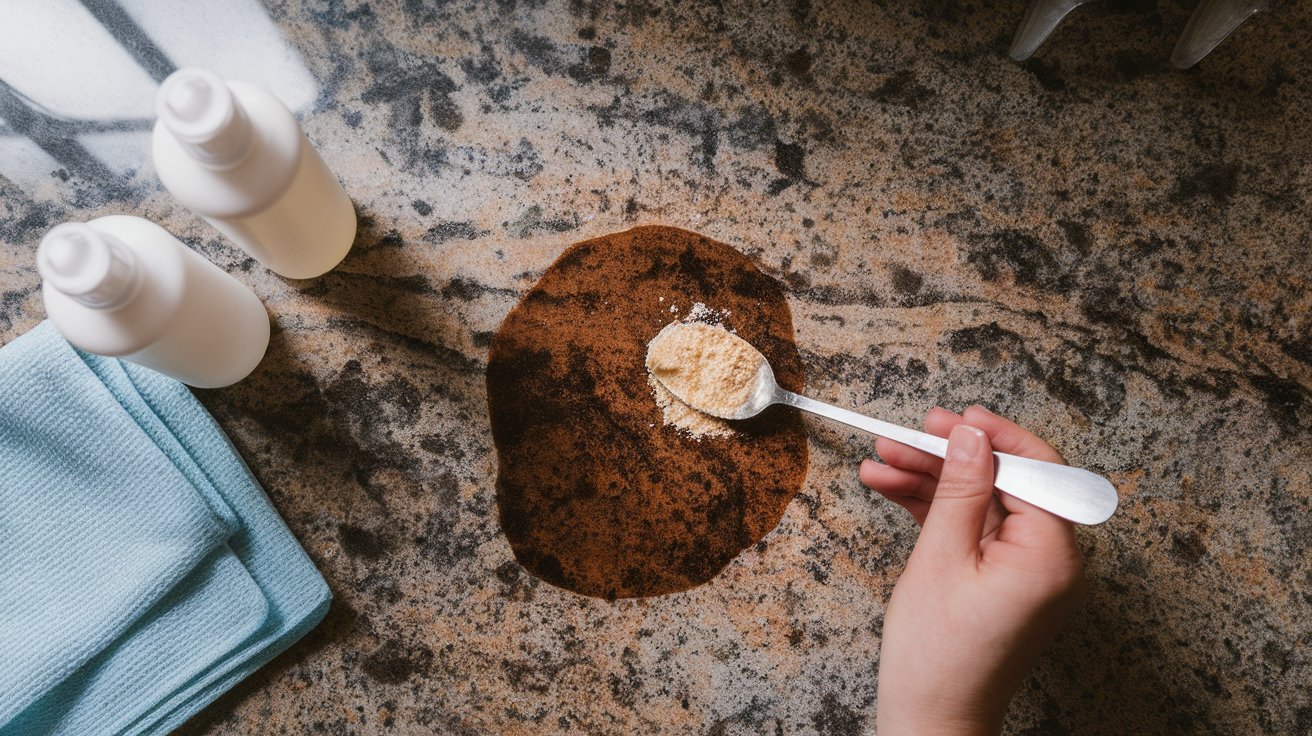Granite countertops are beautiful, durable, and add value to your home. But even the most careful homeowners deal with stubborn stains that seem impossible to remove.
Oil spills from cooking, wine accidents during dinner parties, and water rings from glasses can make your expensive granite look damaged and unsightly.
Here’s the good news: You don’t need expensive professional cleaning services or harsh chemicals to restore your granite. Most stains can be completely removed using simple household items you already have in your kitchen and bathroom.
This complete guide will walk you through proven methods to remove every type of granite stain. You’ll learn which household materials work best, step-by-step techniques for different stain types, and when to seek professional help for severe damage.
Granite Stain Basics One Should Know
Understanding how granite stains will help you choose the right removal method. Granite is a natural stone with tiny pores that can absorb liquids when not properly sealed. This is why spills can penetrate the surface and create lasting marks.
There are two types of granite damage you might encounter. Stains appear darker than the surrounding stone and are caused by substances soaking into the granite’s pores.
Etching looks lighter or whiter and happens when acidic substances like lemon juice or vinegar damage the stone’s surface.
The key to successful stain removal is identifying what type of mark you’re dealing with. Stains can be removed with the methods in this guide, while etching requires professional restoration.
Always test any cleaning method on a small, hidden area first to ensure it won’t damage your specific granite type.
Best Granite Stain Removal Method for Different Stain Types
Different stains require specific approaches, but the basic principles remain consistent across all types. The key to successful stain removal is acting quickly and using the right method for each situation.
Materials Needed to Remove Stains from Granite
Before you start cleaning, gather these common household items:
| Material | Purpose | Notes |
|---|---|---|
| Water | Base for cleaning solutions | Warm water works best |
| Natural dish soap | Gentle cleaning agent | Use a gentle formula only |
| Baking soda | Main stain removal agent | Creates an effective paste |
| Cornstarch | Oil stain absorption | Specifically for grease stains |
| Hydrogen peroxide | Extra cleaning power | Use a 3-4% concentration |
| Microfiber cloths | Cleaning and drying | Must be lint-free |
| Plastic wrap | Cover during treatment | Keeps the paste moist |
| Masking tape | Secure plastic wrap | Holds treatment in place |
| Soft-bristled brush | Gentle scrubbing | Avoid scratching the surface |
| Bowl | Mixing pastes | For creating solutions |
Important: Never use vinegar, lemon juice, or acidic cleaners on granite. These substances can damage the stone's surface permanently.
1. For Oil Stains
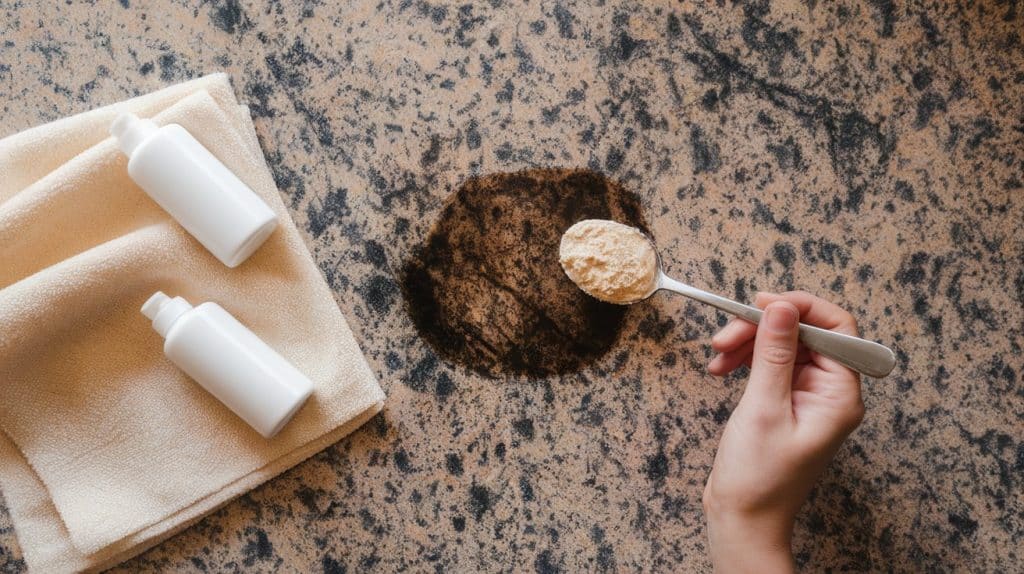
These are common kitchen accidents but respond well to proper treatment.
Start by blotting the oil immediately with a clean microfiber cloth. Don’t wipe or rub, as this spreads the stain further across the surface. Mix a few drops of natural dish soap with warm water, dampen your microfiber cloth in this solution, and gently clean the stained area. Rinse with clean water and dry completely.
If the stain remains, create a thick paste using cornstarch and water. Apply this paste directly to the stain and cover with plastic wrap. Let it sit overnight – the cornstarch will absorb the oil from the granite. Remove the plastic wrap and wipe away the paste with a damp cloth, then clean with soap and water.
For oil-based stains, baking soda paste works exceptionally well – mix 2-3 tablespoons of baking soda with 1 tablespoon of water to create a thick paste. This natural solution draws oil out of the granite’s porous surface without causing damage.
2. For Water Stains
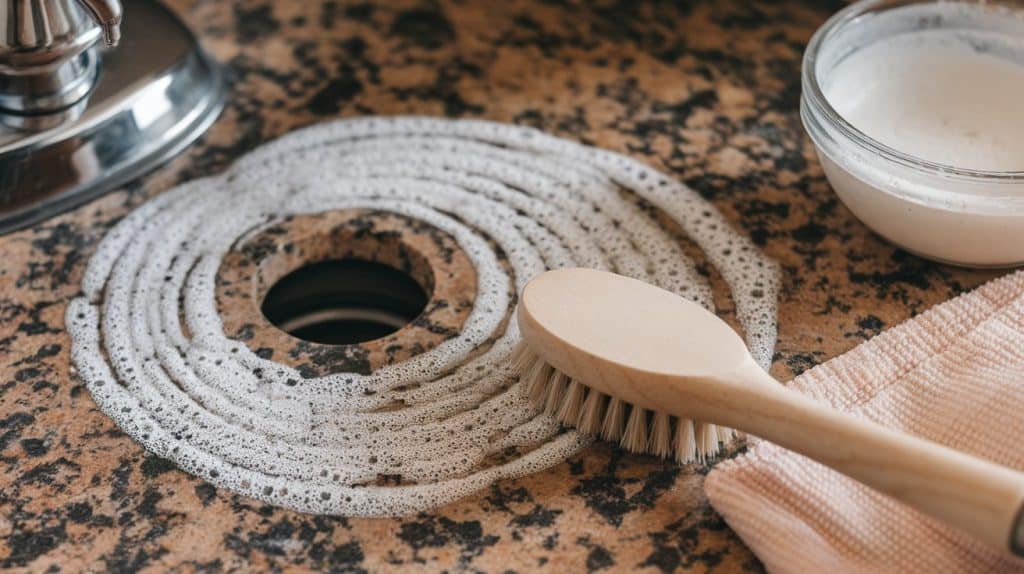
These appear as cloudy rings or spots, especially in areas with hard water. These marks often develop around faucets or where glasses sit regularly.
Start by gently cleaning the water stain with a soft-bristled brush and a mixture of dish soap and warm water. Rinse and dry completely.
For Tough Water Stains:
If water stains persist after the initial baking soda treatment, apply the paste generously to the affected area, cover with plastic wrap, and let it sit for 24-48 hours.
For tough mineral deposits, use a plastic scraper to remove the dried paste, then clean the area with soap and water. In extreme cases, carefully use a one-sided razor blade, but be extremely gentle to avoid scratching the granite.
3. For Wine Stains
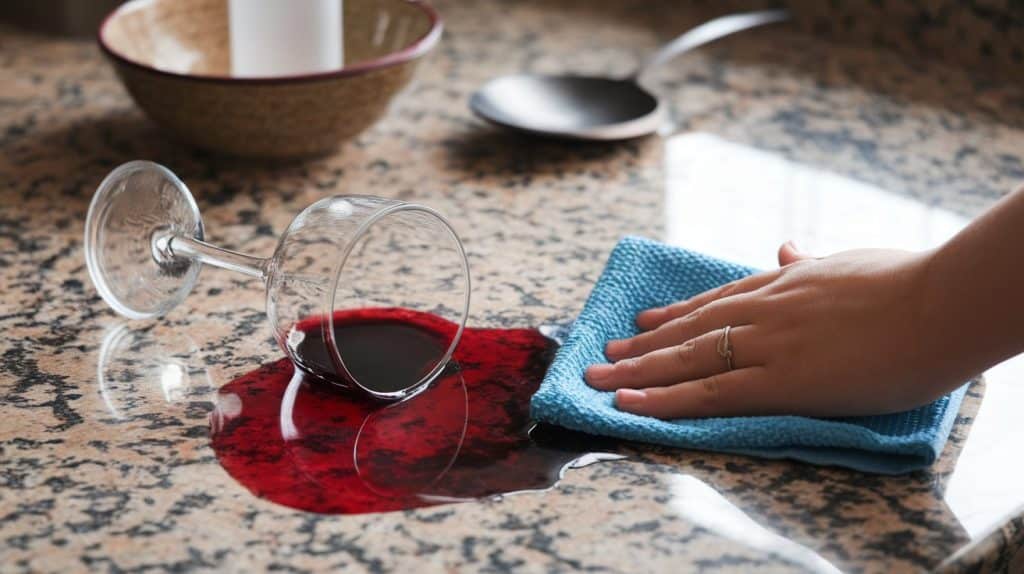
These require special attention due to their acidic nature and dark color. Immediately soak up wine spills with a dry microfiber cloth. Work from the outside of the stain toward the center to prevent spreading.
Mix warm water with a few drops of dish soap and clean the stained area gently with a damp microfiber cloth, then rinse and dry.
For Persistent Wine Stains:
If wine stains resist the basic baking soda treatment, mix 2 tablespoons of baking soda with 1 teaspoon of hydrogen peroxide to form a paste.
Apply this mixture to the stain and cover with plastic wrap for 24 hours. The hydrogen peroxide gives extra cleaning power for organic stains like wine, coffee, and fruit juices.
4. For Fresh Food and Drink Spills
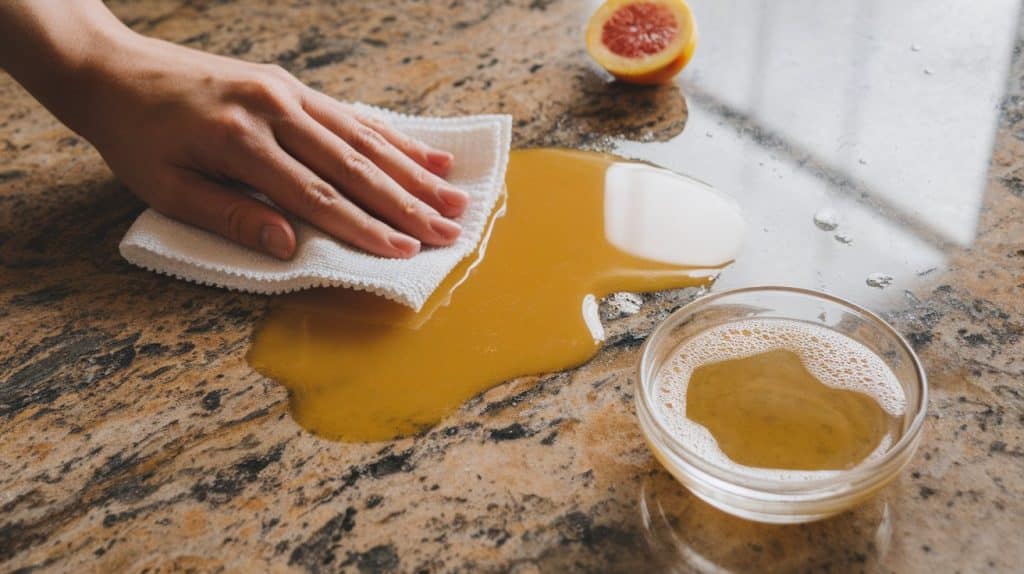
Clean them immediately using warm water and a few drops of dish soap. This prevents the stain from setting into the stone’s pores. Blot liquid spills rather than wiping to avoid spreading the stain across the surface.
For organic stains like wine, coffee, and fruit juices, a combination of baking soda and hydrogen peroxide provides extra cleaning power. Commercial granite cleaners can help, but household baking soda often works just as well at a fraction of the cost.
5. For Stubborn Stains
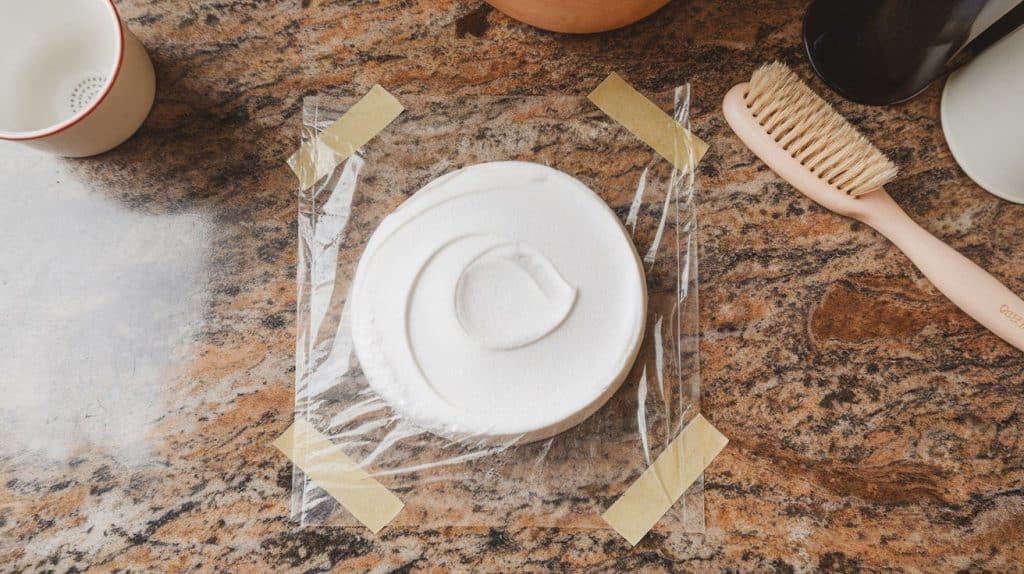
When basic cleaning doesn’t work, move to the baking soda paste method. Create a paste using equal parts baking soda and water for most stains.
Apply a thick layer over the stain and cover with plastic wrap. Secure the edges with masking tape and let it sit for 24 hours. This method works for stubborn food stains, persistent water marks, and most organic substances.
After any treatment, remove the plastic wrap and clean away the paste with a damp cloth. Rinse thoroughly with clean water and dry with a microfiber cloth. Some stains may require multiple treatments for complete removal.
When to Call a Professional for Granite Stain Removal?
Sometimes DIY methods aren’t enough, and professional help becomes necessary.
If stains remain after multiple treatment attempts or if you notice light, whitish marks (etching) on your granite, contact a professional stone restoration specialist.
Look for certified stone care professionals who specialize in natural stone restoration. They have access to professional-grade cleaners and polishing compounds that can address deeper stains and surface damage.
Signs you need professional help:
- Stains that won’t budge after 3 treatment attempts
- White or light spots (etching damage)
- Large affected areas
- Valuable or antique granite surfaces
Preventing Future Stains on Granite Countertops
Prevention is always better than removal when it comes to granite care. Here are essential steps to protect your countertops:
- Apply a granite sealer every 1-2 years to create a protective barrier that prevents liquids from soaking into the stone’s pores.
- Clean up spills as soon as they happen, since the longer a substance sits on granite, the more likely it is to stain.
- Never use vinegar, lemon juice, or other acidic substances on granite, as these can etch the surface and create permanent damage.
- Use coasters under glasses and bottles to prevent water rings and condensation marks.
- Clean with pH-neutral granite cleaners specifically designed for natural stone surfaces.
- Dry surfaces after cleaning to prevent water spots and mineral buildup.
- Use cutting boards to protect from scratches and knife marks that can harbor bacteria.
- Wipe down countertops daily with a microfiber cloth to remove dust and prevent buildup.
- Avoid placing hot pots and pans directly on granite surfaces, as extreme heat can cause damage.
Conclusion
Learning how to remove stains from granite doesn’t require expensive products or professional help in most cases.
With the right materials and techniques, you can tackle oil stains, food spills, water marks, and wine stains using simple household items like baking soda and dish soap.
Remember to act quickly when spills happen, use gentle cleaning methods, and avoid acidic cleaners that can damage your granite. For stubborn stains, patience is key – sometimes multiple treatments are needed for complete removal.
By following these proven methods and maintaining your granite properly, you can keep your countertops looking beautiful for years to come.
When DIY methods don’t work, don’t hesitate to contact a professional stone restoration specialist for help. Do let me know in the comments below about your stain removal experience.

